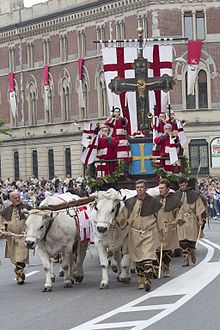Carroccio

The carroccio was an ox-drawn triumphal chariot used by the medieval republics of Italy .
It was a rectangular platform on four wheels, on which was the banner of the city and an altar. Priests held a service at the altar before the battle, and the trumpeters next to it encouraged the soldiers. During the battle, the carroccio was surrounded by the bravest of warriors and served as both a rallying point and a symbol of the city. The conquest of Carroccio was considered a defeat and humiliation.
For the first time a Carroccio 1038 was used by the Milanese . He played an important role in the wars of the Lombard League against the Roman-German Emperor Friedrich Barbarossa ( Battle of Legnano ). After that it was taken over by other cities and first appeared on a Florentine battlefield in 1228 . The Florentine carroccio was usually followed by a smaller car with the martinella , a bell for military signals. When war was imminent, the Martinella would be hung and rung over the door of the Santa Maria del Mercato Nuovo church in Florence to warn citizens and enemies. In peacetime, the carroccio was kept by an important family who had distinguished themselves for their service to the republic.
In today's political parlance in Italy, the term Carroccio stands for the Lega Nord party .
Web links
- Publications on the Carroccio in the Opac of the Regesta Imperii
